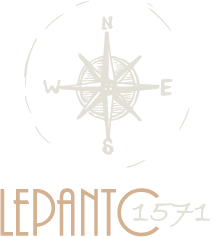The monastry of St. John of Vomvokou
The monastery of St. John (Hagios Ioannis) is situated at about 10 klms NE of Naupaktos, at a small distance from the municipality of Vomvokou, on a mountainous and precipitous area.
Architecture
The katholikon of the monastery is particularly interesting. Its architectural type is Cross-shaped with four columns and a dome, six-sided apse and a narthex. The transversal antennas of the cross end up in six-sided apses as well, like the choruses in the architecture of Mount Athos. Bi-lobed windows open up on the polygonal apses. The roof is pitched, covered with tiles with a bell-tower at the western side. The small dome has twelve sides and is decorated with arches, shallow niches and single-arched windows. Decorative strips of indentated tiles run along the façades of the church.
The west side, where the main entrance lies, is decorated with two sculptures incorporated in the wall, but of unknown provenance. On the left, also incorporated in the wall, a part of a Byzantine parapet with a hare snatched by an eagle in relief. On the right there is an inlaid coat of arms of a Venetian lord with a relief depiction of a feather and a bird's footprint within a shield-shaped frame from which two fringed ribbons are hanging. The marble inscription between the two sculptures informs us that the abbot Arsenios restored the church “from scratch” in 1695.
Interior decoration
The interior of the church is completely covered with frescoes, possibly dating from the time of the building of the church. The themes of the frescoes are divided in horizontal zones: full-sized saints and saints in medallions (lower zone), scenes from the life of Mary in the middle and scenes from the Life of Christ (upper zone). In the narthex it is depicted, among other things, the prayers' book of John the Baptist and the Praises (Ainoi).
To the south and east of the katholikon there are the monastry's cells. Nowadays the monastery is run by a female community and its masses are particularly solemn. The nuns also maintain a workshop for Byzantine icons.
One can visit the monastery after calling at: 26340 27401
The monastery of Ambelakiotissa
The historic monastery of Panagia Ambelakiotissa is one of the most important ones in the Municipality of Naupaktia and lies within the municipal department of Apodotia at a small distance from the village Ambelakiotissa (formerly known as Kozitsa) and 17 klms from Ano Chora. The location of the village was formerly known also as “Argastiria”, i.e. workshops. This name implies probably that in this region used to live families, such as that of Damianos from Epiros, who were renowned for their art as wood-carvers, silversmiths and goldsmiths.
Architecture and decoration
The katholikon is a three-aisled domed basilica with a rectangular plan, three pairs of columns and one pair of piers and a semi-circular apse which is decorated by seven shallow niches. The church bears a pitched, tiled roof and the ceiling of the naves is formed with domical surfaces. On the outside, at the middle of the western side stands an impressive bell-tower with an apsed central entrance. All the exterior surfaces of the walls are decorated with slabs of stone bearing, in relief, the depictions of trees, flowers, animals, human figures. The inscription in relief on the arch over the entrance informs us that the “architect” from Epiros Christos Ioannou from the village of Stratzina (nowadays Pyrgos at Konitsa) restored the katholikon of Ambelakiotissa in 1847 when Theophilos Papalogis was abbot; it also mentions that the initial year of construction of the temple was 1456. The interior of the church is not decorated with frescoes and it has a wood-carved iconostasis made probably by a local workshop, dated by an inscription at 1874. Some recently restored cells are situated along the south and the west sides.
Relics
The monastery of Ambelakiotissa is also famous for the holy relics and the liturgical objects, some of which are real masterpieces. Among those stands out the hand of St. Polycarp, bishop of Smyrna, which bears a gold revetment, made in 1792 by the local goldsmith Panayiotis Damianopoulos. It is kept within a silver reliquiarium, bearing religious repersentations in relief, made by the local gold-and silversmith N. Damianos.
The icon of the Mother of God, which constitutes the main icon of the church, belongs to the style of the 17th century, but its golden revetment was made in 1820 by the local goldsmith Nicolaos Damianos. Furthermore, a wonderful specimen of golden thread embroidery is the Holy Sepulchre, made by the renowned embroiderer Mariora from Constantinople.
The monastery functions nowadays with male monks. Celebartion days are the 23rd of February, namesday of St. Polycarp, and the 15th of August, on the day of the Dormition of Mary.

